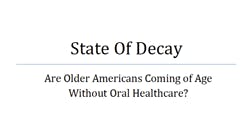Recently, a "report card" published by Oral Health America graded oral health care for older adults in America. The report was titled State of Decay: Are Older Americans Coming of Age without Oral Healthcare? Oral Health America is a national, nonprofit organization whose primary mission is to connect communities with resources to increase access to care, education, and advocacy for all Americans, especially those who are most vulnerable.
The overall concept from the report is that we should be doing better as a society at delivering access to dental care for our older Americans. The report suggested that:
- There is a persistent lack of oral health coverage in older Americans.
- Thirty-one states have high rates of dentist provider shortage areas.
- Tooth loss remains a signal of suboptimal oral health.
- Thirteen states still have at least 60% of residents living in communities without community water fluoridation.
These findings are further described in the report, specifically the lack of dental coverage for older Americans. Pointedly, although children are making strides with dental coverage, there have been no successful efforts to increase funding for dental insurance for older adults. The Affordable Care Act does not address dental coverage for older Americans. Not surprisingly, dental insurance coverage is a primary indicator of whether or not an individual visits the dentist, which is even more important to note when close to 70% of older Americans do not have dental insurance.
--------------------------------------------------------------------
Consider reading these articles by Nathe
--------------------------------------------------------------------
The report uses the following factors to grade oral health for older Americans:
- Access to adult Medicaid dental benefits
- Edentulism
- Current state oral health plans with a goal to promote older adult oral health
- Dental health professional shortage area
- Community water fluoridation
Each state is individually graded on each of these areas. Recommendations from this report included creating payment options for older adult dental care and improving state oral health plans for older adults, enhancing workforce solutions for primary dental care, expanding community water fluoridation efforts, and educating significant stakeholders on older adults' dental needs.
This type of data can be important to dental hygienists working to develop solutions for oral health care issues of older adults in their communities. By using data that depicts this tremendous need to improve state infrastructures and increase preventive efforts, dental hygiene can lead the way in improving oral health outcomes. We must remember that dental hygienists should be playing pivotal roles in developing state-based initiatives to improve the oral health of our most vulnerable older Americans.
CHRISTINE NATHE, RDH, MS, is director at the University of New Mexico, Division of Dental Hygiene, in Albuquerque, N.M. She is also the author of “Dental Public Health Research” (www.pearsonhighered.com/educator), which is in its third edition with Pearson. She can be reached at [email protected] or (505) 272-8147.
References
1 Oral Health America about Us. Retrieved from http://oralhealthamerica.org/aboutus/ on November 12, 2013.
2 Oral Health America. State of Decay: Are Older Americans Coming of Age Without Oral Healthcare? Chicago: Oral Health America, 2013. Retrieved from http://www.oralhealthamerica.org/pdf/StateofDecayFinal.pdf on November 12, 2013.






